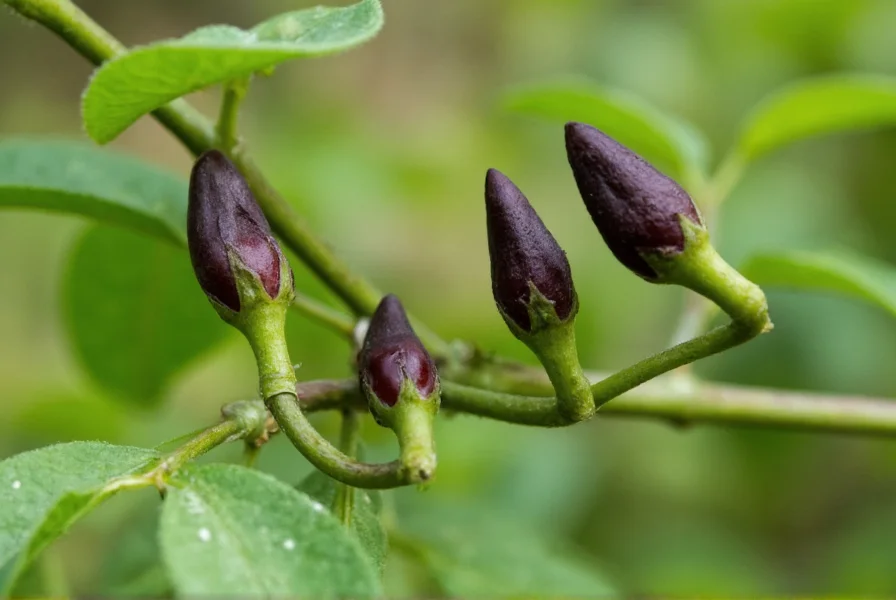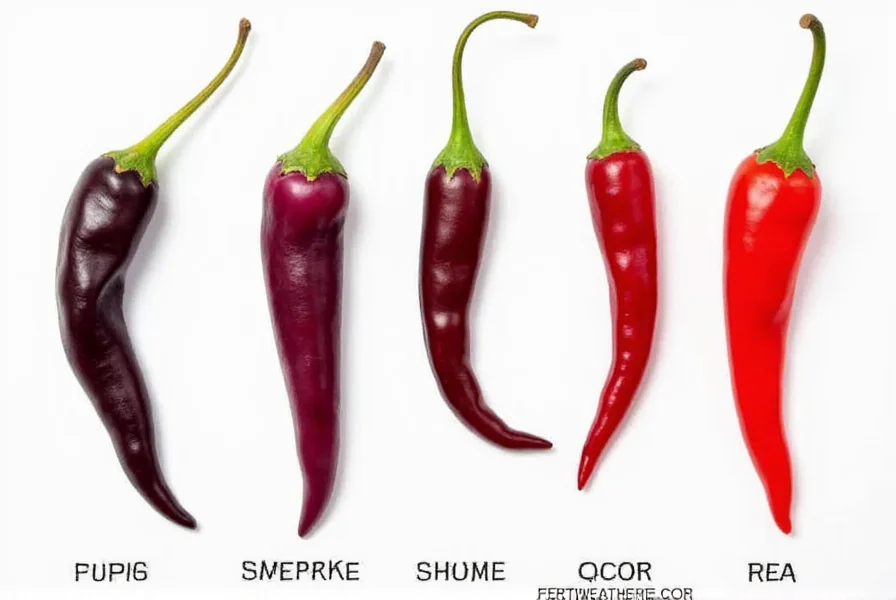Among the world's most intense chili peppers, the devil's tongue pepper stands out for its unique appearance and formidable heat. This Capsicum chinense variety has gained attention among heat enthusiasts and culinary explorers seeking extreme spice experiences. Unlike more common superhots, the devil's tongue pepper remains relatively obscure in mainstream markets but has developed a dedicated following among chili connoisseurs.
Physical Characteristics and Maturation Process
Devil's tongue peppers display remarkable visual transformation throughout their growth cycle. When immature, these peppers showcase a striking purple-black hue that gives them their distinctive name. As they mature, they transition through deep burgundy shades before reaching their final vibrant red stage. The pods typically measure 1-2 inches in length with an elongated, slightly curved shape reminiscent of a devil's forked tongue.
| Characteristic | Devil's Tongue Pepper | Comparison to Ghost Pepper |
|---|---|---|
| Scoville Heat Units | 800,000-1,200,000 | 855,000-1,041,427 |
| Plant Height | 24-36 inches | 36-48 inches |
| Maturation Time | 90-110 days | 100-120 days |
| Flavor Profile | Fruity with smoky undertones | Fruity with sweet notes |
Origin and Cultivation Requirements
While precise origins remain somewhat mysterious, evidence suggests devil's tongue peppers likely emerged from selective breeding of Caribbean and South American chili varieties. These plants thrive in tropical and subtropical climates but can be cultivated indoors with proper care. Successful cultivation requires:
- 12-14 hours of direct sunlight or equivalent grow lighting
- Consistent temperatures between 75-85°F (24-29°C)
- Well-draining soil with pH 6.0-6.8
- Regular watering without waterlogging
- High humidity levels during flowering
Gardeners report that devil's tongue pepper plants produce moderate yields compared to other superhots, with harvests typically occurring 90-110 days after germination. The distinctive color transformation makes these plants particularly attractive as ornamental specimens, even for those not seeking extreme heat.

Culinary Applications and Flavor Profile
Despite their intimidating heat level, devil's tongue peppers offer a complex flavor profile that extends beyond mere spiciness. When used judiciously, they contribute:
- A distinct fruity aroma with subtle berry undertones
- Smoky depth that enhances certain dishes
- Noticeable heat that builds gradually rather than immediately
- A lingering warmth that can last 15-20 minutes
Chefs specializing in extreme heat cuisine recommend using devil's tongue peppers in applications where their unique characteristics can shine without overwhelming other flavors. Popular uses include:
- Specialty hot sauces where the distinctive color adds visual appeal
- Meat rubs for smoked barbecue preparations
- Infused oils for controlled heat application
- Experimental craft beers and spirits
When working with devil's tongue peppers, safety precautions are essential. Always wear gloves when handling, avoid contact with eyes or sensitive skin, and work in well-ventilated areas to prevent inhalation of capsaicin particles.
Comparison with Similar Superhot Peppers
While often compared to other extreme heat varieties, devil's tongue peppers maintain unique characteristics that distinguish them from more common superhots:
- Carolina Reaper: Significantly hotter (1,400,000-2,200,000 SHU) with a more intense, immediate burn
- Ghost Pepper: Slightly milder heat with sweeter initial flavor notes
- Trinidad Moruga Scorpion: Similar heat range but with more pronounced fruitiness
- 7 Pot Douglah: Comparable heat with chocolate-brown mature pods
The devil's tongue pepper's distinctive maturation colors and slightly different heat progression make it a valuable addition to any serious chili enthusiast's collection. Its heat builds more gradually than many superhots, allowing the complex flavor notes to register before the intense burn fully develops.

Safety Considerations for Handling Extreme Heat Peppers
Working with devil's tongue peppers requires serious safety precautions due to their extreme capsaicin concentration. Professional chili handlers recommend:
- Using nitrile gloves (latex provides insufficient protection)
- Wearing eye protection to prevent accidental contact
- Avoiding facial contact during preparation
- Working in well-ventilated areas or using fume hoods
- Having dairy products nearby to counteract accidental exposure
For those experiencing capsaicin exposure, immediate treatment with whole milk, yogurt, or other dairy products provides the most effective relief. Water typically worsens the burning sensation as capsaicin is oil-soluble rather than water-soluble.
Where to Find Devil's Tongue Peppers
Due to their relative rarity, devil's tongue peppers aren't commonly found in standard grocery stores. Your best options for obtaining them include:
- Specialty chili farms and online retailers focusing on rare peppers
- Chili enthusiast forums and seed exchanges
- Regional farmers markets in areas with strong chili-growing cultures
- Specialty hot sauce producers who may use this variety
When purchasing seeds, verify the seller's reputation and ensure they provide proper growing instructions, as mislabeled superhot varieties are unfortunately common in the market.
Final Thoughts on This Unique Superhot
The devil's tongue pepper represents one of the more distinctive entries in the world of extreme heat chilies. Its dramatic color transformation, complex flavor profile, and formidable but manageable heat make it particularly appealing to experienced chili enthusiasts seeking something beyond the standard superhot varieties. While not for the uninitiated, those willing to approach this pepper with proper respect and safety precautions will find a uniquely rewarding culinary experience that combines visual drama with intense flavor complexity.











 浙公网安备
33010002000092号
浙公网安备
33010002000092号 浙B2-20120091-4
浙B2-20120091-4